Moving Through Me as I Move
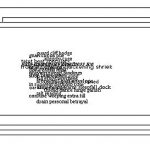
Techno-poet Stephanie Strickland surveys the digital artistic practices of her peers and presents a "paradigm for interaction."
Vannevar Bush wanted his Memex to intercept and capture the neural circuits of the stenographer who could reduce his words to a phonetic code on the fly, whose encoding practice was encompassed by her body. As an electronic poet, I want to do the same thing, not from the position of Bush, outside the device, but from the position of the stenographer, attached to it. In her body, words moved through her as she moved, a fluent circuit of meaning that she hosted, instigated, permitted, understood, explored, and enjoyed.
Bush exhibited some justified fear as to whether her practice would be complete and accurate according to his standards:
A girl strokes [the stenotype’s] keys languidly and looks about the room and sometimes at the speaker with a disquieting gaze. From it emerges a typed strip which records in a phonetically simplified language a record of what the speaker is supposed to have said. Later this strip is retyped into ordinary language, for in its nascent form it is intelligible only to the initiated. (Bush 1994, section 3, paragraph 3 [emphasis added])
He also wanted to capture the neural knowledge she attained by intervening in the production of the text:
The impulses which flow in the arm nerves of a typist convey to her fingers the translated information which reaches her eye, in order that the fingers may be caused to strike the proper keys. Might not these currents be intercepted, either in the original form in which information is conveyed to the brain, or in the marvelously metamorphosed form in which they then proceed to the hand? (Bush 1994, section 8, paragraph 6)
Hers is a somatic practice that deflects not only the threat of analytic dispersal, into “simplified language… nascent form… intelligible only to the initiated,” as Bush characterizes her code, but also the threat of obsessive recombination and confusion, the multiple overlapping streams of speech she is asked to transcribe.
The notion of “moving through me as I move,” as a paradigm for interaction, intends to install the stenographer, and not her employer, as the crucial creative/receptive presence in digital art. Hers is an egalitarian position that can be stated of, and by, each element in a dynamic network. “Move through me as I move” is as much the “voice” of a hypertext as it is of the writer/encoder. It is also the voice of the network addressing all those hosting it and served by it. In the case of work open to multiple authoring, or to synchronous reading and performance, the command “move through me as I move” represents the utterance of each of the performers and participants speaking to all the others. In this mutual command there is an implicit promise of fluent mutual adjustment to whatever comes.
The stenographer, however, is more than a writer/reader/monitor; she is also the operator of an appliance. This position is described by Talan Memmott (2001), here explicating his theory/fiction hybrid, Lexia to Perplexia, winner of the 2000 trAce/altx New Media Writing competition:
With a document that is acted upon, unfolded, revealed, opened rather than read, full of holes to elsewhere, hiding secret inScriptions, filled with links like mines and traps and triggers — we are no longer talking page or screen, but appliance. Navigating the Lexia of Lexia to Perplexia is kind of like getting a new device and trying to figure out how the heck it works… (Memmott 2001)
The stenographer moves within an unforeseeable context. Communicating by “strokes” in an energized yet languid atmosphere, she is absorbed, alert, and somehow also free to gaze about the room — the aspect that most disquieted Bush. She participates in a form of dancing in which the lead changes many times a minute, her moments of apprehending/encoding activity giving way to deep moments of passive reception in a regular alternation or oscillation.
An oscillating, or flickering, pattern has often been invoked with regard to electronic art. Katherine Hayles has said, “We have only begun to construct a semiotics that takes into account the different functions signifiers perform when they cease to be flat marks and become instead layers of code correlated through correspondence rules” (Hayles 2000). In recognition of the layered dynamic interactions between text and code, she proposed the term “flickering signifiers” for text onscreen. Both Richard Lanham (1993) in The Electronic Word and Bolter and Grusin (1999) in Remediation have remarked the importance of an oscillation between the viewer positions of “looking at” and “looking through”; that is, between experiencing works primarily as heavily mediated and “windowed,” in the software sense, or primarily immediate and immersive, as in looking through transparent glass. I would like to propose a third kind of flickering or oscillation, the oscillation that occurs between the processing of alphabetic text and the processing of image in works that use both. A digital writer who uses image and text is in fact writing a score for their shifting interrelation.
Flickering or oscillating poems differ from pure sound and pure image work in the following respect: whereas sound layered on sound creates new sound, and image on image makes a new image, alphabetic text, superimposed on alphabetic text or on image, does not reliably yield legible text. In the poems that explore this truth, one flickers between seeing the viewable and reading the legible. Jim Rosenberg (1996) and (Mary-Anne Breeze 2000) are poets who approach this movement very differently.
Rosenberg (figure 15.1) works with the words and phrases of a standard vocabulary but overlays them in a dense blur of self-interfering micro-information. A presenting image of tangle is literally drawn apart by hand into legible text, but no sooner do words come into focus than the slightest mouse movement dissolves them back into blur. These texts thus move through the reader, as she moves, at exactly the pace her hand/brain browses — and superimposed on that oscillation, one experiences a constant trembling across the view/read cusp.
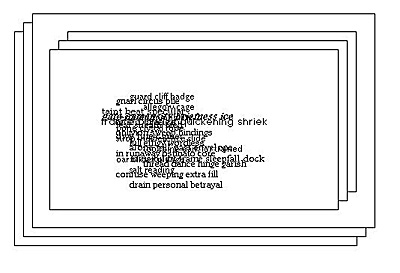
CAPTIONMARKERSTARTFigure 15.1: Jim Rosenberg, The Barrier Frames (Eastgate Systems)CAPTIONMARKEREND
Mez, on the other hand, in a practice she calls “M[ez]ang.elle.ing,” leads us to confront the legible with strategies ordinarily reserved for the viewable. A good characterization of her work comes from a source that, on the face of it, has nothing to do with poetry. Michael Cohen’s (1992) ” Blush and Zebrackets: Two Schemes for Typographic Representation of Nested Associativity” describes two tools that treat words and documents as pictures, in order to create denser data without loss of legibility. Cohen has understood that one can intensify both the density of picture data and the legibility of read data at the same time. He says of these tools:
Creative orthography frees words from traditional… constraints, allowing textual re-presentation of multidimensional concepts by projecting multilayered structure into linear text. Extended electronic typography… provides additional parsing cues… (Cohen 1992, 449)
If we add the idea of both packing and unpacking compound symbols, we have an excellent description of Mez’s practice, excerpted sentences of which, from her e-mail writing, appear in figure 15.2:
Re][stuttered][[sutured][: not][net][.art
Date:
Wed, 21 Feb 2001 10:56:26 +1100
][the x.press][ed 4 time,
4 the answer,
4 the dreamic caul 2 a][r][mories][][
][jumper lead.ing 2 a p][asse][o][mo][lished cliff-curve][
.drain the cu][s]p n datadrown.
…+
…+[not.art is][net][a rutting corpse-knot]+
…+
+please stop+
+++ please l][ectro][][gl][isten +++
Figure 15.2: Excerpts from Mez’s email writing
What Mez attains, that Cohen, in his search for greater legibility, does not attempt, is the feat of keeping us in motion from one view/read cusp to the next, seeding the screen with many cues for reading backwards, up and down, and slantwise, as well as forward. Indeed, we are often stopped in our tracks, caught in a kind of pleasurable stutter and thrown back to rescan the whole field, a perceptual act more often associated with image. Mez’s text/image pictures allow for multiple, plural, and contradictory readings of her text. In her article, “The Art of M[ez]ang.elle.ing,” Mez (2000) lists fourteen goals or techniques, which include:
2 phone.tic[k-tock]aulli m-bellish a tract ov text in2 a neo.logistic maze;
2 network 2 the hilt N create de[e]pen.den[ting]cies on email lizts for the wurkz dis.purse.all;
2 uze computer kode kon.[e]vent.ionz spliced with irc emoticons and ab[scess]breviations.
She says, in an e-mail to the Webartery list [December 20, “Visual Minds” thread (2001a)]: “I personally tend 2 b drawn 2wards the fragment, the smaller echos/works, and I think this reflects my n.herent need 2 m.ulate the network packet/communication mentality…” She is drawn, that is, to emulate her partner, the network, to follow its lead even as she leads it through her constructions.
By contrast, Jim Andrews (2001a), who gives us the term “langu(im)age,” works with individual letters which he can animate and overlay with sequences of sound loops in his Nio (figure 15.3) engine.

CAPTIONMARKERSTARTFigure 15.3: Jim Andrews, NioCAPTIONMARKEREND
He is not primarily, or at all, concerned with providing a reading experience. He says:
Much of my work is lettristic in the sense that rather than working with words and extended texts, I work with individual letters. Part of my attraction to working this way is philosophical and sonical… but part of it is also out of interest in treating literary objects/material, and individual letters are quite well suited to such treatment. Individual letters are graphically more interesting than whole words… [they] take up less memory, and are thereby manipulated more quickly. And they spin nicer than words do, for instance, because of their shapes. There is more variety in their shapes than there is in words. And they are quite mysterious to me. Geometry and basic architectures of language. (E-mail to Webartery list, February 10, 2001, on thread “re: teaser 2” [2001b])
Later, he says: ”… it’s really when you get down to the word and the letter, rather than the paragraph, that language cracks open and code spills out” [Webartery list, February 24, on thread “checkout counter”]. One feels the difference from the stenographic model, a model of accommodation rather than breaking and entering. But one also feels, and can sympathize with, an attraction to a different arena, the world of the purely sonic and visual, where compounds stay themselves and are thereby experienced more fluidly. However, oscillation does occur in Andrews’s Nio, between the visual and the sonic elements, and this oscillation is elegant, playful, and deeply pleasing.
My own work investigates oscillation between image, text, sound, and animation, both within and between linked units. In this way, several states or layers of oscillation, a set of cross-rhythms, come into being.
In 1995, I translated my book-length poem True North to Storyspace. The True North themes of navigation and embeddedness moved from being print concepts, refracted in language, to being the steering mechanism and constitutive structure of the hypertext. The Storyspace software provides many ways to operate the poem, but they are not intuitive: to move fluidly one must spend time learning the rich interface. For this textually driven work about navigation, I designed the two most important orienting elements to be visual. The first of these is a set of mouse-drawn Storyspace maps. Figure 15.4 shows two of them, “The Mother-Lost World” and “There Was an Old Woman.” Figure 15.5 shows two others, maps of the sections called “Language Is a Cast of the Human Mind” and “Numbers Nesting in Numbers-Nesting-In Numbers.”

CAPTIONMARKERSTARTFigure 15.4: Maps from True North: “The Mother-Lost World” and “There Was an Old Woman”CAPTIONMARKEREND
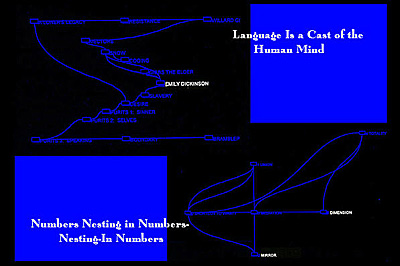
CAPTIONMARKERSTARTFigure 15.5: Maps from True North: “Language Is a Cast of the Human Mind” and “Numbers Nesting in Numbers-Nesting-In Numbers”CAPTIONMARKEREND
The emblematic map shapes, with their legends of node names, can be read by themselves. These sitemaps, functioning as pattern poems, give a very fair idea or sampling of True North — a mode of understanding that may supplement, or substitute for, following links and reading text. Such a displacement of text by image, that also functions recursively as a guide to text, is itself a distinct mode of oscillation — one which coexists with the familiar reference oscillation between a map and what it maps.
The coloring of a few words on each page is the second orienting device (figure 15.6). Since Storyspace does not use color to signify text-links, instead requiring the reader to press a key to reveal boxes around link words, each color operates visually to suggest a connection between similarly colored words: each color is an embedded link, but one traceable only by human memory, not by software.

CAPTIONMARKERSTARTFigure 15.6: Word colors suggest connections, but not places to clickCAPTIONMARKEREND
A different kind and rate of oscillation occurs in To Be Here as Stone Is (1999), a digital poem written collaboratively with M. D. Coverley. This poem is composed of two very different sorts of screens: six highly visual ones with sound that use complex Anfy Java applets (figure 15.7) and thirteen primarily textual ones where lines of verse are overlaid on a visual background (figures 15.8a and 15.8b) itself layered with a text ribbon. The links between these promote a rapid exchange between two kinds of attention, between primary viewing/listening and primary reading/searching, for the links must be sought for, by cursor scanning, on the textual pages. The experience of strongly discernable shift resonates with the text of this poem that shifts the reader from photons to cosmos and back.
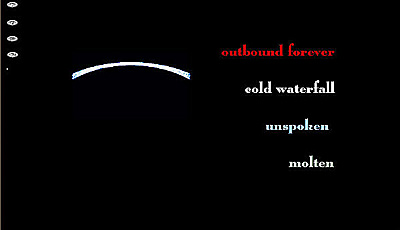
CAPTIONMARKERSTARTFigure 15.7: A Java applet screen in To Be Here as Stone IsCAPTIONMARKEREND
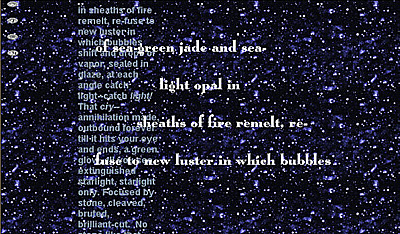
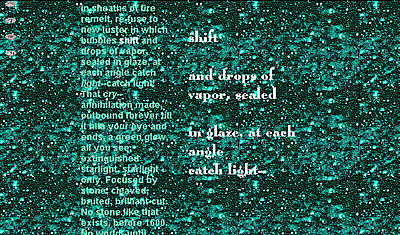
CAPTIONMARKERSTARTFigure 15.8a and Figure 15.8b: Primarily textual screens in To Be Here as Stone IsCAPTIONMARKEREND
In the Flash poem, Errand Upon Which We Came, Coverley and I (2000/2001) choreographed animation for the alphabetic text as well as for accompanying images and sound. The reader/operator of this text may press the silver butterfly to the screen if she wishes to read with complete accuracy, but she may prefer to oscillate between sampled reading and periods of viewing. The words of Errand address the reader, speak to her of fragmented mobile text; speak to her, in fact, of the very act of reading she has undertaken: in response, she may actively intervene in the poem to read or redirect it, or she may attend to it as a movie.
In figure 15.9, we see a moment in the life of the Flash stanza that begins with the question “space?” floating down from the top of the screen, followed by a second question about knowledge-mining. A flock of butterflies flies in from upper right and circles around toward screen center. A third and fourth question, about “go(o)ds” refusing to go to market, appear onscreen. They imitate the butterflies’ circling motion. At the end of the Flash movie we see two dimnesses in the central far distance, one, the almost out-of-sight V of butterflies; the other, the lines of the last two questions, now collapsed to one extremely faint line poised at the butterflies like a lance. The question is posed visually as to whether the image and text must attack each other, or may perhaps exist in oscillating accommodation.
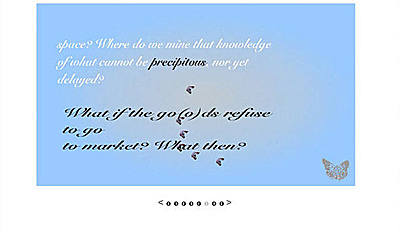
CAPTIONMARKERSTARTFigure 15.9: Moment of Errand Upon Which We CameCAPTIONMARKEREND
The Ballad of Sand and Harry Soot (Strickland 1999), coded with the help of Janet Holmes, creates a seeming disjunction of image and text on each of its 33 similarly designed pages. The pages are highly visual, but their unmoving text asks to be read. Images from Jean-Pierre Hébert’s (1999) Sisyphus — a device shown at SIGGRAPH 1999 that inscribes algorithmic patterns in sand with a steel ball — are the ones most prevalent in the Ballad. In figure 15.10 both Sisyphus and a Sisyphus pattern can be seen. Other images suggestive of digital or mathematical culture, such as a Metro card, webcam photos, a core dump, or an animated fractal, accompany the text of a love poem, a ballad of love gone wrong or at least not entirely right, between two characters called Sand and Soot. At one level, the disjunction of image and text mirrors the difficulties of this pair; however, the particular discordance, or nonreference, that seems to exist between image and text will, at some point, spring into resonant oscillation for the reader who either sees, or reads, an avatar of carbon-based chemistry in Harry Soot and one of silicon life in Sand.
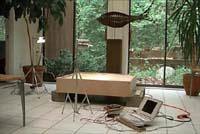
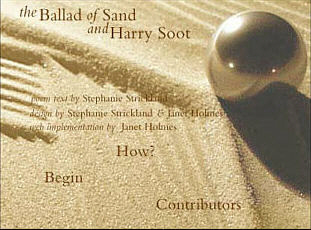
CAPTIONMARKERSTARTFigure 15.10: Sisyphus and a Sisyphus patternCAPTIONMARKEREND
Four key images in the Ballad were created by Alex Heilner and shown at the Sixth Annual Digital Salon. On his contributor page within the Ballad, Heilner (Strickland 1999) explains: “This series of `microbe’ images… seeks to invert traditional understanding of our internal and external environments. Large, orthogonal, built objects… have been re-imagined here to represent the most basic organic living beings…”
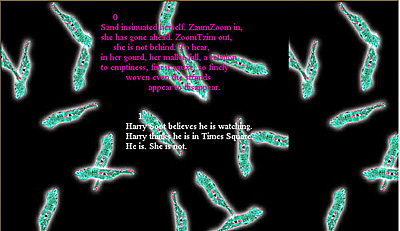
CAPTIONMARKERSTARTFigure 15.11: Manhattan as microbesCAPTIONMARKEREND
Thus, in figure 15.11, we see that Heilner has represented the island of Manhattan so that it reads as a collection of floating microbes. Scale is elided on the Web, as it is in the stenographer’s practice, where events in the conference room, in her brain, in her hand, and on her code-filled writing machine are nearly simultaneous. Many different scales can be present to the same screen, as if they belonged together, as if they cohered there as “naturally” as they do in the stenographer’s body. But a change in scale is a change of context: the view/read cusp will shift differently for zoomed text than it will for text that is panned. In fact, this kind of zoom or scale-changing cusp may be a particularly important one in a world where we are asked to process simultaneously scales from the nano to the cosmic.
Delivered to and through new media, we find new understandings. Delivered to and through new media, the bitstream displays varying modalities that our bodies and brains have long been used to processing differently. We shift differently, we censor differently, we move differently, to sound, to text, to image, and to animation. Today, perforce, we are learning to oscillate differently, in new “ratios,” as Blake or McLuhan would say. The stenographer at her stenotype was an early pioneer of this environment. Her continual active choice to attend or to blur her focus, to remain poised or to flow within the moving stream, is a task we take up. We will not all take it up the same way. We bring many biophysical and cultural heritages to the task. It is for this reason that my collaborators and I choose to make work that can be operated, and thus read, across many modalities at many rates and rhythms of oscillation.
Responses
References:
Andrews, Jim (2001a). Nio. http://www.turbulence.org/Works/Nio/.
---. (2001b). E-mail to Webartery list, February 10, 2001, on thread “re: teaser 2.” http://www.egroups.com/community/webartery.
---. (2001c). E-mail to Webartery list, February 24, 2001, on thread “check out counter.” http://www.egroups.com/community/webartery.
Bolter, Jay David, and Richard Grusin (1999). Remediation: Understanding New Media. Cambridge, MA: The MIT Press.
Bush, Vannevar (prepared by Deny Duchier) (1994). “As We May Think.” http://www.isg.sfu.ca/~duchier/misc/vbush/. [dead link]
Coverley, M.D., and Stephanie Strickland (1999). “To Be Here As Stone Is.” Riding the Meridian 1, no. 2 (1999). http://califia.hispeed.com/SI/stone1.htm.
---., and Stephanie Strickland (2000/2001). “Errand Upon Which We Came.” Cauldron & Net 3 (Winter/Spring 2000/2001). http://califia.hispeed.com/Errand/title1a.htm.
Cohen, Michael (1992). “Blush and Zebrackets: Two Schemes for Typographical Representation of Nested Associativity.” Visible Language 26, no.3/4 (1992): 436-449.
Hayles, N. Katherine (2000). Commentary section of “The Dinner Party.” Riding the Meridian 2, no. 1 (Spring 2000). http://www.heelstone.com/meridian/templates/Dinner/hayles.htm.
Hébert, Jean-Pierre (1999). Sisyphus. http://hebert.kitp.ucsb.edu/sand/sand.html.
Joyce, Michael (2000). Othermindedness: The Emergence of Network Culture. Ann Arbor: University of Michigan Press.
Lanham, Richard A. (1993). The Electronic Word: Democracy, Technology, and the Arts. Chicago: University of Chicago Press.
Memmott, Talan (2000). “Lexia to Perplexia.” The Iowa Review Web (September 2000). http://www.uiowa.edu/~iareview/tirweb/hypermedia/talan_memmott/index.html.
---. (2001). Interview, Rhizome, January 16, 2001. http://rhizome.org/object.rhiz?2145.
Mez (Mary Anne Breeze) (2000a). E-mail to Webartery list, December 20, 2000, on thread “Visual Mind.” http://www.egroups.com/community/webartery.
---. (2000b). “The Art of M[ez]ang.elle.ing: Constructing Polysemic & Neology Fic/Factions Online.” Beehive 3, no. 4 (December 2000). http://beehive.temporalimage.com.
Rosenberg, Jim (1996). “Barrier Frames.” Eastgate Quarterly Review of Hypertext 2, no. 3 (1996). http://www.well.com/user/jer/j/barrier_frames_4.html.
Strickland, Stephanie (1999). Ballad of Sand and Harry Soot. WordCircuits. http://wordcircuits.com/gallery/sandsoot/.
---. (1999). “To Be Both in Touch and in Control,” ebr 9 (Spring 1999).
---. (1998). True North. Watertown, MA: Eastgate Systems.
Cite this essay
Strickland, Stephanie. "Moving Through Me as I Move" Electronic Book Review, 5 November 2004, https://electronicbookreview.com/publications/moving-through-me-as-i-move/